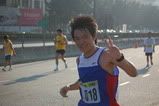Stretching for new runners
Why stretch?
10 tips on how to stretch
5 essential stretches
A)Why stretch?
Stretching before and after exercise is very important for all runners. The benefits from stretching are that you may prevent injury, bring the shortened muscles back to their original length, and to reduce or avoid post exercise stiffness. When you stretch you are trying to increase the range of movement around a joint or a group of joints. This helps to strengthen the joint and to increase the flow of blood into the muscles around the joint.
Before exercise, in the warm-up, you want to prepare the muscle for activity. The best time to stretch is just after a short easy jog and to hold each stretch for 10 seconds. It is especially important if you intend to start an intense activity such as sprinting or speed-work.
After exercise, in the cool-down, you want to bring back the muscles used to their original length. During activity the muscle shortens, you notice this when the muscle gets tight and hard. To reduce or even prevent post exercise muscle stiff-ness you are now trying to lengthen and loosen the muscle back to its pre-exercise level. You should hold the stretch for longer - 30 seconds.
Below are stretches we recommend you as a minimum do before and after running. There are many more good stretches but these five exercises will be a good start to prevent you from getting injured.
B)Ten tips on how to stretch
i) Move slowly into the stretch.
ii) Hold the stretch for 10 seconds prior to exercise (warm-up) and for 30 seconds post exercise (cool-down).
iii) Breathe and relax while holding the stretch.
iv) NEVER do any bouncy stretching, always hold and relax.
v) Focus on the muscle you are trying to stretch and then try to lengthen it.
vi) You may be able to breach in and push the stretch slightly further half way through the stretch. This is most important during cool-down.
vii) Move slowly out of the stretch again.
viii) Remember to stretch both sides.
ix) Increasing the range of movement around a joint will help the blood flow to the muscles surrounding the joint and increase circulation that will carry away any lactic acids that may build up in the muscle.
x) Do more stretching that just warm-up and cool-down. A lot of gyms offer stretch-classes where the aim is to permanently and progressively to increase your flexibility.
C) 5 essential stretches
i)Calf – Gastrocnemius
– Gastrocnemius
Step one foot a large step in front of the other
Feet parallel, pointing forward
Back heel flat on the ground
Hands on the front bend knee
Back straight and head slightly down
FEEL the stretch in the calf of the back leg
ii )Lower calf - Soleus
)Lower calf - Soleus
One foot in front of the other, small step
Weight on the back leg
Feet parallel, toes pointing forward
Both heels down
FEEL the stretch in the lower calf of the back leg
iii)Ham
 strings
stringsOne foot in front of the other, a small step apart
Sit back on the back leg (weight on the back leg
Stretch front leg (flex foot upwards for extra resistance)
Lift your buttocks
Hands on bend leg
Stomach in, head lifted and back straight
FEEL the stretch in the straight leg – just below your buttocks
Push bend foot into your hand at the ankle – Not your toe
Use a wall or partner for balance
FEEL the stretch in the quad (hip) of your bend leg and try to move the muscle out for extra flexibility

Cross feet by taking one foot in front of the other (the right foot in front)
Find your balance and keep your back straight
Front leg slightly bend
Push left hip slightly left, away from the centre of you body
Hands along side of your body
FEEL the stretch on the outside of your left leg








No comments:
Post a Comment